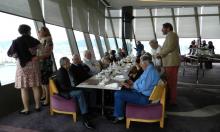1909 Back to the White Star Line, and getting married
Primary tabs
After having a couple of weeks leave I reported to the White Star Line that I was ready to take up my duty again. I was ordered to join the "Celtic" then in dry dock as 3rd, Officer. There was then a shipping slump and many out of employment. The Celtic sailed for New York and then on a Mediterranean Cruise calling at the Islands on the way. It was a lovely run in a lovely ship. I think we made another trip to the Mediterranean on our return to New York - our usual calls were Gibraltar, Genoa and Naples I went to see the ruins of Pompeii. We returned to the New York - Liverpool run and I was shifted to the "Cedric" Captain Bartlett R.N.R. was the Captain afterwards Commodore Bartlett RD RNR.
After many trips across the Atlantic I got in touch with a Liverpool Company (Dun & Co.(chals)) who had a Steamer trading between New York and the west coast of South America, they eventually offered me to go Chief Officer of their new ship then building in Glasgow. The American Steel Corporation of New York had a lot of interest in these ships the name of the steamer was the "Howick Hall" two funnels of about 8000 tons (carrying) quite a fine vessel about 11 to 15 speed. I was promised a master's position after doing one trip as mate - which turned out correct however the west coast was a hard coast and rough we handled a good deal of shifting weights I was not too keen on it and always away from home. I was made master of the s/s Howick Hall after my first trip, on my return to New York home leave for which I was pleased, this would be in 1912 when the Titanic was lost on her maiden trip after hitting the ice-berg with over 1000 passengers lost. I went home in the s/s "Celtic" (1st Class), and was interviewed on arrival by M/s. Dunn & Co. Then I went home to Bryn Coch my beloved home with my dear mother, father, a sister, and a brother still there. On leave this time I met my wife to-be, then Miss M.E. Davies; daughter of the Rev. H. Davies. We were married in Sept. 1912.
My only reason for leaving the White Star Line was the slow promotion. It made me sad to leave the Company; the finest steamers the world has ever known including the R.M.S. Oceanic were built by them. She was the most luxurious, cost over £1,000,000 to build and a speed of 21 knots. They were beautiful sea-boats and floating palaces, but I felt that I had better leave - the Company was later almost swallowed up by the Cunard and called the Cunard White Star Line Combine and hundreds of Officers lost their jobs.
After my marriage I lived at my wife's home and from there I was called to join the S.S. Santa Rosalia at New York as soon as possible. On arrival the vessel was already waiting for me, loaded, and at anchor, however there was no captain - mate and 2nd and 3rd officers were already by the ship, and all the crew, who were all almost belonging to the Roman Catholic Religion whom turned out to be very awkward as time went on I discovered they were all against me to such an extent that I had to take drastic action (The story is a long one). I sailed in this vessel the following morning with cargo for Buena Ventura Bolivia Victoria and Vancouver and Prince Rupert, and on the return journey we picked up cargo at Portland Oregon and San Francisco tin and case goods also called at St. Rosalia in the lower Gulf of California loaded 2000 tons of Copper for France the remainder of the cargo was for the British Isles, Avonmouth, Swansea and Harwich. We paid all the crew off. All the officers were compelled to get out on account of their disobedience and new officers were appointed in their place. Some cargo of tin was loaded at Swansea and when ready we sailed for New York where we loaded again for the same ports in British Colombia and Prince Rupert. We had a British crew and they gave me a lot of trouble - drunk and off duty in every port returned again to England - owing to my Reserve training being due I left on our arrival hoping to rejoin in some 6 months time.
I went through my Gunnery and Torpedo courses and then joined for a Fleet Test Mobilisation. I was appointed to the H.M.S. "Hannibal" an old Battleship all manned by R.N.R. officers except the Gunnery and Torpedo officers. The ships were ammunitioned and stored up to war necessity. We eventually sailed for the grand review which was to take place at Spithead (Portsmouth) for H.M. Inspection, the gathering of the whole fleet gathered together off Spithead in the early part of August. I was in the H.M.S. Hannibal fully stored with ammunition and on war footing the same as the remainder of the fleet. Commander Samson R.N. was then a flying man and was flying above the fleet for the best part of the day accompanied by two other airmen. Flying in those days was a very tame thing but constantly improving. The Fleet broke up and cleared out to sea and carried out manoeuvres. H.M.S. Hannibal's propeller was damaged by one of the other ships in Barging ahead whilst in station of single line ahead - which meant that she had to go into Plymouth (Davenport) to have the propeller fixed.

